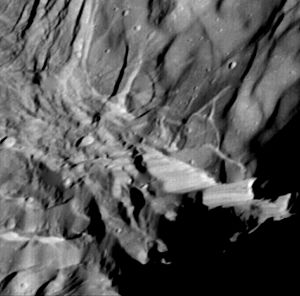Cliff facts for kids
A cliff is a very steep or straight-up natural wall of rock. Imagine a giant, tall rock face that drops sharply down – that's a cliff! Cliffs are formed over a long time by natural forces like weathering (when rocks break down) and erosion (when wind, water, or ice carry away rock pieces).
You can find cliffs in many places, like along coasts where the ocean crashes against the land, in high mountain areas, or even next to rivers. The rocks that form cliffs are usually very strong and don't wear away easily. Common types of rock that make up cliffs include sandstone, limestone, granite, and basalt. Sometimes, a cliff can also be called an escarpment or scarp, especially if it was formed by a geologic fault (a crack in the Earth's crust) or a landslide. Cliffs are also famous for creating amazing features like waterfalls.
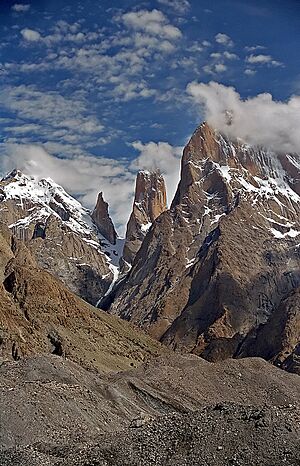
Some of the biggest cliffs on Earth are actually hidden underwater! For example, there's an incredible 8,000-meter (about 5-mile) drop in the Kermadec Trench deep in the ocean.
The tallest cliff in our entire solar system might be Verona Rupes. This giant cliff is about 20 kilometers (12 miles) high and is found on Miranda, one of the moons orbiting the planet Uranus.
Contents
Amazing Cliffs Around the World
Cliffs come in all shapes and sizes, and some are truly massive! Here are some of the most impressive cliffs found on Earth and even beyond.
Cliffs Above the Sea
These are cliffs that drop straight into the ocean or a large body of water.
- Europe:
* Hornelen in Norway stands 860 meters (2,820 ft) above the Frøysjøen fjord. * Croaghaun on Achill Island, Ireland, rises 688 meters (2,257 ft) above the Atlantic Ocean. * Slieve League in Ireland is 601 meters (1,972 ft) above the Atlantic. * Cabo Girão in Madeira, Portugal, is 589 meters (1,932 ft) above the Atlantic Ocean. * The Cliffs of Moher in Ireland are famous, reaching 217 meters (712 ft) above the Atlantic. * The White Cliffs of Dover in England are iconic, standing about 100 meters (328 ft) above the Strait of Dover.
- Asia:
* Qingshui Cliff in Taiwan averages 800 meters (2,625 ft) above the Pacific Ocean. The tallest peak here rises an amazing 2,408 meters (7,900 ft) directly from the ocean!
- Oceania:
* Mitre Peak in New Zealand soars 1,683 meters (5,522 ft) above Milford Sound. * Kalaupapa in Hawaii is 1,010 meters (3,314 ft) above the Pacific Ocean. * Ball's Pyramid is a sea stack (a tall rock island) that is 562 meters (1,844 ft) high but only 200 meters (656 ft) wide at its base!
- Africa:
* Kogelberg in South Africa is 1,289 meters (4,229 ft) above False Bay in the Atlantic Ocean. * Table Mountain in Cape Town, South Africa, is a famous landmark, standing 1,086 meters (3,563 ft) above the Atlantic.
Cliffs Above Land
These cliffs rise dramatically from the land below, often in mountainous regions.
- Asia:
* Nanga Parbat's Rupal Face in Pakistan is an incredible 4,600 meters (15,100 ft) high, making it one of the world's tallest rock walls. * The Trango Towers in Pakistan have faces that drop over 2,000 meters (6,560 ft) to the glaciers below. * Lhotse's south face in Nepal is 3,200 meters (10,500 ft) tall.
- Europe:
* Troll Wall in Norway is Europe's tallest cliff, rising 1,100 meters (3,600 ft) from its base. * Mięguszowiecki Szczyt in Poland has a north face that rises 1,043 meters (3,422 ft) above a lake. * The famous "six great north faces of the Alps" include the Eiger (1,500 m / 4,920 ft) and Matterhorn (1,350 m / 4,430 ft).
- North America:
* Mount Thor on Baffin Island, Canada, is often considered to have the largest vertical drop on Earth, plunging 1,250 meters (4,100 ft) straight down. * El Capitan in Yosemite Valley, California, United States, is a massive granite cliff, about 900 meters (3,000 ft) high. * Notch Peak in Utah, U.S., has a pure vertical drop of about 670 meters (2,200 ft). * The East face of the West Temple in Zion National Park, Utah, is believed to be the tallest sandstone cliff in the world, at 670 meters (2,200 ft).
- South America:
* Pared Sur Cerro Aconcagua in Argentina is a huge cliff face, 2,700 meters (8,860 ft) high. * Auyan Tepui in Venezuela is a flat-topped mountain with cliffs about 1,000 meters (3,300 ft) high. This is where Angel Falls, the world's highest waterfall, plunges down! * The faces of Cerro Torre and Cerro Chalten in Patagonia, between Chile and Argentina, are famous for their steepness, reaching up to 1,200 meters (3,900 ft).
- Africa:
* The Drakensberg Amphitheatre in South Africa is a huge cliff face, 1,200 meters (3,900 ft) high and 5 kilometers (3 miles) long. The Tugela Falls, the world's second tallest waterfall, drops 948 meters (3,110 ft) over this cliff! * Mount Meru, Tanzania has caldera cliffs that are 1,500 meters (4,900 ft) high.
Cliffs as Homes for Wildlife
Cliffs offer special homes for many different plants and animals. Their tall, vertical surfaces provide unique places to live. For example, many birds love to build their nests on cliffs. This is because cliffs are often very safe from predators (animals that hunt them) and are hard for other creatures to reach.

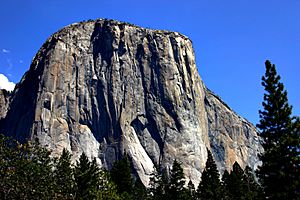
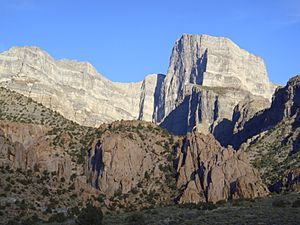
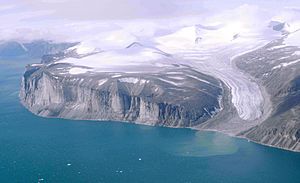
Images for kids
-
The far southwestern aspect of Nanga Parbat's Rupal face, highest cliff (rock wall/mountain face) in the world. The steepest part of the face is 2 km to the northeast.
-
Vihren’s 460 m north face seen from Golemiya Kazan, Pirin Mountain, Bulgaria
-
Cliffs along the north shore of Isfjord, Svalbard, Norway.
-
Kaliakra cape cliffs, Bulgaria
-
The Cliffs of Moher in Ireland
-
Vratsata gorge, Vrachanski Balkan Mountains, Bulgaria
See also
 In Spanish: Acantilado para niños
In Spanish: Acantilado para niños


